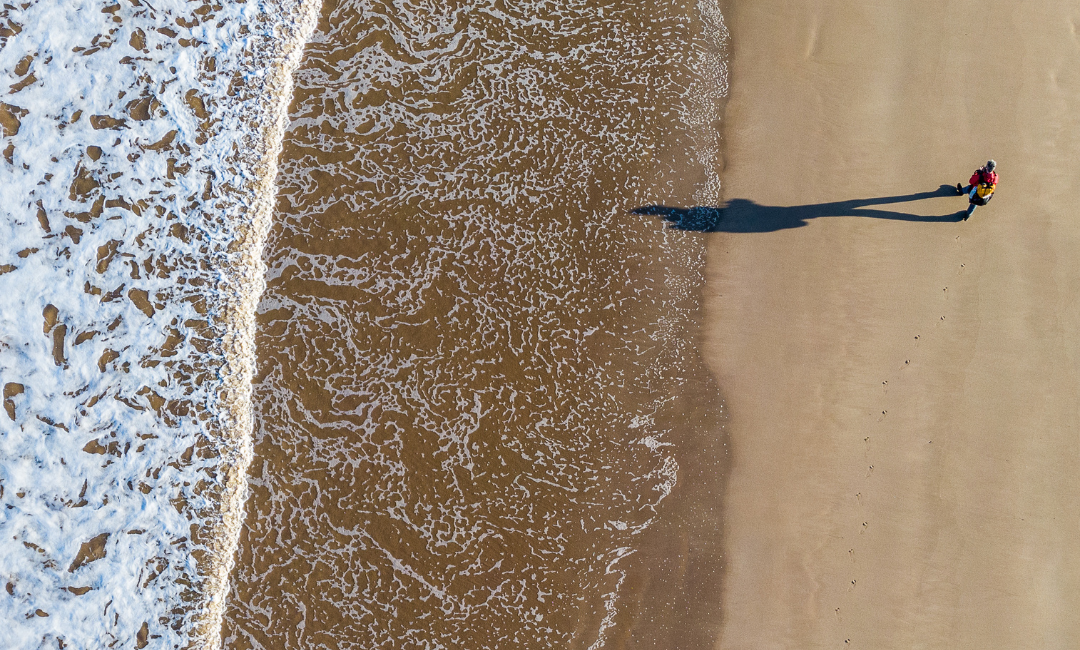
Tracing the Perimeter
In 2015, photographer Quintin Lake set off on an epic journey, which would take him clockwise on foot around the perimeter of mainland Britain over the next five years. Self-sufficient for five days at a time, he set out to record the intricacies of the United Kingdom, its coastline, and its coastal communities with his camera. Now, as Quintin publishes his work in a 450 page photographic book, he speaks with us to reflect on his project.
What was your inspiration for The Perimeter expedition?
Walking has been central to my life – right from my early time in the Scouts, to my experiences with the Territorial Army, Raleigh International, and the British Exploring Society. I did my first big walk (all 480km) aged ten, and before I was 20, I’d walked 1,677km from Land’s End to John O’Groats in winter.
The idea for The Perimeter was born in 2014 as I recovered from meningitis. On bed rest, I craved the outdoors and, as soon as I was well enough, planned a walk along the Thames, from its trickling source at Kemble, Gloucestershire to the Houses of Parliament. Next, I walked along the Severn, Britain's longest river, from the source to the sea. As I walked, camera in hand, I was captivated by the stark contrast between nuclear power stations and pylons sat against a backdrop of vast tidal sands. I grew hungry to discover more of the coast, to capture this inspiring in-between world that was neither land nor sea. Why not walk the whole thing?
Having seen a few stretches of England on foot, what surprised you about your journey?
I was most surprised by how remote and inaccessible many of the Scottish peninsulas are – in winter, I sometimes didn't see anyone for four or five days at a time. Many sections required me to forge my own way, clambering over rocks and backtracking repeatedly when the ground got too steep or the vegetation too dense. Knoydart remains in my heart as the most beautiful and challenging section. It is a landscape that required the most persistence to traverse yet repaid it many times over with the most intense photographic reveries.
How did you manage your food intake and nutritional demands?
In the winter in Scotland, I was often walking off-trail from dawn to dusk, covering 25km in wet, near-freezing conditions. I needed 4-5k calories per day so I ate a lot of tuna, sardines, beef jerky, porridge, couscous, peanut butter, and oatcakes. In the evening, I'd have a large-sized Firepot meal. My evening regime was usually to stop at an interesting landmark before sunset so I could photograph in daylight, dusk, and darkness, which maximised the chance of capturing a strong image. I remember boiling water for a Firepot meal at Castle Tioram by Loch Moidart, which allowed me to continue photographing as the meal rehydrated. I ate it as the sky darkened, continued photographing in the darkness, and walked into the night with my stomach warm.
How did you go about packing for such an expedition? Did you allow yourself any luxuries?
Aside from my camera gear (which weighed 5kg), I kept my camping setup to a bare minimum. Walking 25km per day, I obsessed over every gram, often cutting labels of my clothes as a form of recreation on rest days! What else I carried depended on the time of year – my pack could be as little as 10kg in the warmer months, and up to 24kg in the winter. The closest I got to a luxury was Gehwol Extra foot cream to massage the base of my tired feet at the end of a long day, but even this weight was only justified as I knew it meant I could cover more miles more easily.




Did you listen to any podcasts/audio books and, if so, which?
Usually I'm an avid nonfiction podcast and audiobook listener, but I tried to limit my listening time to when my body ached or my motivation waned. I was constantly battling to conserve battery power as I often went five days at a time without charging up, but I also wanted to be present in the moment as much as possible to see images in the landscape. The audiobooks that stayed with me from the walk include Anglo Saxons and Castles by Marc Morris, Dopamine Nation by Dr Anne Lemke, Ultra Processed People by Chris van Tulleken, Deep Work by Cal Newport, The Sea Around Us by Rachel Carson, A History of Scotland by Neil Oliver, A Time of Gifts by Patrick Leigh Fermor, and We are Nature by Ray Mears.
What were your take-aways from five years of walking?
I feel very strongly that the landscapes I encountered are not just scenic vistas but vibrant ecosystems which are now facing significant threats from climate change and human impact. Global warming has precipitated flooding that disproportionately impacts low-lying areas of the country and will speed up erosion in the soft coastlines of East Yorkshire. In the seemingly pristine Kyles of Bute, the strandline contained hidden pockets thick with layers of marine plastic pollution. Some progress has been made – the numerous windfarms I saw were a heartening sign that action is being taken, and beach clean-ups have been instrumental in keeping our shores free from the worst visible plastic – but more needs to be done to preserve our oceans and our coastline. I hope my photographs and stories will inspire a greater appreciation of and commitment to preserving the natural world.
I’m also mindful of how much more needs to be done to make the outdoors accessible. Having spent half of this journey in Scotland where the right to roam afforded me the freedom to explore, it saddens me that in England, we only have a right of access to 8 per cent of the land and 3 per cent of the rivers. There is mounting evidence of the physical and mental health benefits from being outdoors; it seems unsustainable and inequitable for open spaces, woods and riverbanks to remain private property, as it is in so much of England and Wales.

Were others to follow in your footsteps and trace coastal Britain on foot, what would your advice for them be?
Philosophically, my advice would be not to rush. Take it as slowly as you can. You'll never regret slowing down and lingering somewhere beautiful.
Physically, I would say take the likelihood of overuse injury seriously when carrying 25kg for thousands of km. I had a torn tendon and shin splints, and a bunch of other overuse injuries. I learnt the hard way that eating whole foods, sleeping enough and stretching while on the trail are essential. On a long backpacking journey like this, there can be a fine line between the virtue of digging deep and finding the determination to continue in adversity, and the vice of ignoring what your body is telling you when it's overloaded. As the Stoics put it, you must know in yourself how far and when to push hard and when to change tactics.
Do you have any other projects on the horizon?
Since The Perimeter, I've finished walking all sixteen National Trails. I'm over halfway through my current project, walking up the 442 mountains of England and Wales and camping on the summits when the weather permits.
Quintin began his 11,000km journey at St Paul’s Cathedral in London on the 17th April 2015. After 455 days walking and 268 days of editing, Quintin has produced a book, which contains over 1,200 photographs. To him, The Perimeter is 'not just an end but a beginning. I hope this book inspires others to embark on their own adventure along our coast.’
The Perimeter, by Quintin Lake, is available here. Published by Hutchinson Heinemann.
Image credits: © Quintin Lake, 2025








